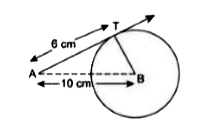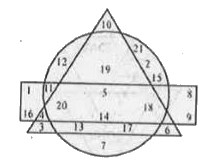In the energy band diagram of a material shown below, the open circles and filled circles denote holes and electrons respectively. The material is a/an

p-type semiconductor
insulator
metal
n type semiconductor
The correct Answer is:A
The given figure represents p-type semiconductor as described below
When one of the silicon atom (valence =4) has been replaced by an atom of aluminium (valence =3), the aluminium atom can bond covalently with only three aluminium atom can bond covalently with only three silicon atoms, so there is now a "missing" electron (a hole) in one alumiumium-silicon bond with a small expendicture of energy, an electron can be torn from a neigbouring silicon-silicon bond to fill this hole, thereby creating a hole in that bond. similarly, an electron from some other bond can be moved to fill the second hole. In this way, the hole can migrate through the lattice.

The alumunium atom is called an acceptor atom because it readily accetps an electron from a neighbouring bond that is from the valence band of silicon. As figure suggests, this electron occupies a localized acceptor satate that lies within the energy gap, at an average energy interval Ea above the top of the valence band. By adding acceptor atoms, it is possible to increase very greately the number of holes in the valence band.
Topper's Solved these Questions
- SEMICONDUCTOR ELECTRONICSBOOK - A2ZCHAPTER - SEMICONDUCTOR ELECTRONICSEXERCISE - AIIMS Questions
38 Videos
- SEMICONDUCTOR ELECTRONICSBOOK - A2ZCHAPTER - SEMICONDUCTOR ELECTRONICSEXERCISE - Assertion Reason
18 Videos
- SEMICONDUCTOR ELECTRONICSBOOK - A2ZCHAPTER - SEMICONDUCTOR ELECTRONICSEXERCISE - Section B - Assertion Reasoning
22 Videos
- NUCLEAR PHYSICSBOOK - A2ZCHAPTER - NUCLEAR PHYSICSEXERCISE - Section D - Chapter End Test
29 Videos
- SOURCE AND EFFECT OF MAGNETIC FIELDBOOK - A2ZCHAPTER - SOURCE AND EFFECT OF MAGNETIC FIELDEXERCISE - Section D - Chapter End Test
30 Videos
Similar Questions
Knowledge Check
In a semiconducting material, the mobilities of electrons and holes are μe and μh respectively. Then
Aμe<μhBμe=μhCμe<μhDμe>0 but μh<1Which of the energy band diagrams shown in the figure corresponds to that of a semiconductor?
A B
B C
C D
D
Assertion: If there is some gap between the conduction band and the valence band, electrons in the valence band all remain bound and no free electrons are available in the conduction band. Then the material is an insulator.
Reason: Resistance of insulators is very lowAIf both assertion and reason are true and reason is the correct explanation of assertion.BIf both assertion and reason are true not but reason is not the correct explanation of assertion.CIf assertion is true but reason is falseDIf both assertion and reason are false.
For the circle shown below, find the length. (in cm) of the largest cord of the circle.

View SolutionDraw the "energy bands" diagram for a (i) pure semiconductor (ii) insulator. How does the energy band, foe a pure semiconductor, get affected when this semiconductor is doped with an acceptor impurity donor impurity? Hence discuss why the 'holes' and the 'electrons' respectively, become the 'majority charge carriers' in these two cases.
View SolutionIf p is the resistivity of a material, and n is the number density of free electrons in it, the mean time between collisions between electrons in the material is given by: (m denotes the mass of an electron, and e denotes the charge on an electron)
View SolutionFor the circle shown below, find the length (in cm.) of the largest chord of the circle.

View SolutionStudy the following diagram consisting of a circle, a rectangle and a triangle and answer the question given below it.

If the circle is called 'rectangle rectangle is called triangle' and triangle is called 'circle', which number is only in the triangle but not in other two diagrams?
View Solution


